Acoustic Gaming: Imperial Assault – Review
by Ste
| Title | Imperial Assault | |
| Publisher | Fantasy Flight Games | |
| No of Players | 2-5 | |
| Suggested Ages | 14+ | |
| Playing Time | Appx. 60 minutes per mission | |
| Official Site | https://www.fantasyflightgames.com/en/products/star-wars-imperial-assault/ |
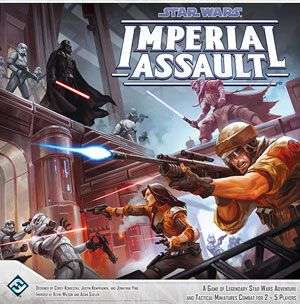 Aren’t you a little short for a Stormtrooper? Oh, you’re not a Stormtrooper, sorry. Yes, you are just a normal(ish) person reading a crap intro to a review. Okay, now that we’ve cleared that up I guess I’ll just stop messing about… Imperial Assault is an action-adventure miniatures board game for 2-5 players by Fantasy Flight Games. Set in the Star Wars universe between episode IV, A New Hope and episode V, The Empire Strikes Back, Imperial has two game modes straight out of the box: Campaign which is for 2-5 players and has a pretty cool RPG element, and Skirmish which is a 2 player only, 1v1 tactical affair, with objective-based scenarios.
Aren’t you a little short for a Stormtrooper? Oh, you’re not a Stormtrooper, sorry. Yes, you are just a normal(ish) person reading a crap intro to a review. Okay, now that we’ve cleared that up I guess I’ll just stop messing about… Imperial Assault is an action-adventure miniatures board game for 2-5 players by Fantasy Flight Games. Set in the Star Wars universe between episode IV, A New Hope and episode V, The Empire Strikes Back, Imperial has two game modes straight out of the box: Campaign which is for 2-5 players and has a pretty cool RPG element, and Skirmish which is a 2 player only, 1v1 tactical affair, with objective-based scenarios.
N.B. There is currently one full expansion available for Imperial Assault, with another on the way, plus numerous additional Ally and Villain packs available for purchase. For the purpose of this review and to avoid unnecessary confusion, only the core game will be discussed here.
Firstly let’s talk about components: 34 plastic miniatures, one of them being a big AT-ST Walker, 59 interlocking map tiles, 11 dice and a multitude of different tokens, markers and thingymajigs. There is a hell of a lot in the box, along with four instruction booklets – Learn to Play, Rules Reference Guide, Skirmish Guide and Campaign Guide – and it can all seem incredibly overwhelming to begin with. Don’t let this put you off though, Imperial Assault is actually very easy to learn and play and, after initially punching out all the components, you’ll be up and running in no time. You’ll be glad to know that in typical Fantasy Flight Games style, all the components are incredibly high in quality; the 28mm miniatures, which represent the players, enemies, and the like are an exceptional example, and the AT-ST in particular is especially beautiful. Unfortunately the miniatures don’t come painted, but I have, however, been having a great deal of fun painting these myself. Of course you don’t have to paint the miniatures if you don’t want to, but it’s definitely worth it and there are plenty of good guides and videos online to help you if you’re new to it, like I am.
The rest of the components are great as well, and the card used for the tokens and map tiles is a very heavy stock card which, while not invincible, is very hard wearing. Speaking of the map tiles, these double sided tiles join together like a jigsaw to make up the surface that Imperial Assault is played on. This idea isn’t new but it works extremely well and allows many varied backdrops and landscapes to be constructed. My only complaint in regards to the map tiles is that the jigsaw-like fit is very tight and if you’re not careful when taking the pieces apart it is possible to damage the interlocking “teeth” on your tiles. I’ve started to noticed some slight fraying of the cardboard teeth on my tiles after some moderate use, and it seems that this is unavoidable.
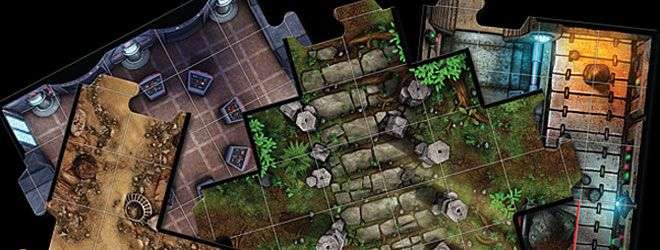
As mentioned earlier, Imperial Assault comes with two game modes right out of the box – the Campaign and Skirmish Modes. In the Campaign mode, one player will act as an Overlord or Game Master who has the dual role of guiding the other players through their adventure, as set out by the Campaign guide (which only this player is allowed to read), and controlling the Empire’s forces. Up to four other players will take up the roles of powerful Rebel heroes who will do battle against the weaker but more prolific Empire. Each mission will start with some flavour text from the campaign guide, which is read out by the Imperial player, and the map is then constructed using the tiles stated by the guide.
The Rebel heroes will have a starting position, some initial Imperial forces will be placed on the map, and other tokens such as terminals, crates and other bits and bobs are scattered around the map all as per the all-knowing Campaign Guide. The Rebel players will have a certain objective to achieve in order to win the mission, while the Empire player generally just has to stop them. The objectives themselves are quite varied, from simple search and destroy/kill all objectives to rescue attempts and stealing data. Additionally, certain constraints such as time limits can be added into the mix in order to keep the missions fresh and interesting for the players. All this is dictated by the Campaign mode and, from what I’ve played so far, the story is excellent, telling the tale of what happened immediately after the destruction of the first Death Star at the end of Episode IV.
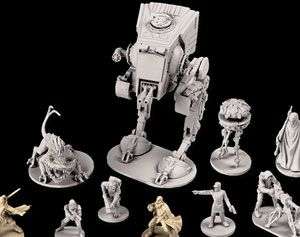 During a mission the Rebels and Imperials take turns to do up to two actions – move, attack or interact. For example, the Rebel Diala Passill, a force-sensitive exile, activates and, for her first action, decides to move. Diala has a speed of 4 so she can move up to that many spaces. In this instance she moves 3 spaces towards a nearby stormtrooper and lands adjacent to him. Diala then decides to attack the Stormtrooper with her staff (as she is a melee based character she has to be adjacent to do this). Her starting weapon is a Plasteel Staff which uses 1 green and 1 yellow die, and the roll of these two dice will determine how much damage the attack will do. As well as damage symbols the dice also show “Surge” icons and numbers to determine accuracy.
During a mission the Rebels and Imperials take turns to do up to two actions – move, attack or interact. For example, the Rebel Diala Passill, a force-sensitive exile, activates and, for her first action, decides to move. Diala has a speed of 4 so she can move up to that many spaces. In this instance she moves 3 spaces towards a nearby stormtrooper and lands adjacent to him. Diala then decides to attack the Stormtrooper with her staff (as she is a melee based character she has to be adjacent to do this). Her starting weapon is a Plasteel Staff which uses 1 green and 1 yellow die, and the roll of these two dice will determine how much damage the attack will do. As well as damage symbols the dice also show “Surge” icons and numbers to determine accuracy.
In Diala’s case accuracy isn’t an issue, however Surge icons can be spent to add certain effects such as additional damage or stun to an attack. It’s worth adding here that some abilities require Rebel players to spend “Strain”; the amount of strain a player can take is determined by the amount of endurance that character has. Strain can be recovered by resting, however not properly managing the amount of strain a player has can cause issues for the Rebels. Imperial players are not restricted by Strain.
The Imperial player then gets to roll a defence die to try and block damage and cancel surge effects. After the attack Diala can choose to spend her remaining movement point and attempt to move away from the stormtrooper and into cover. It would then be the turn of the Imperial player who would activate one of his units. Play alternates between Rebel and Imperials until every unit on the board has taken a turn. At this point the round is over and everything resets. The Imperial player, however, gets the opportunity to reinforce his units by spending “Threat” points. These points are added at the start of every round and are determined by the ever-omniscient Campaign Guide. Each Imperial unit has a value and can be purchased with the corresponding amount of threat. It’s up to the Imperial player when to spend his threat and whether to save up his threat in order to buy the more dangerous but expensive units.
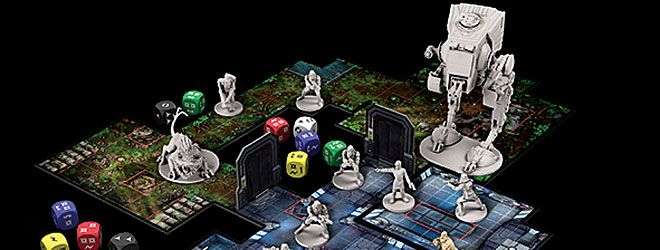
Missions can end in either a Rebel or Imperial win; it is not game over if the Rebels fail to win a mission, it just means that they gain fewer Experience Points (XP) and credits to spend on upgrading their characters. XP can be spent on new abilities such as powerful attacks or even adding additional movement points etc. Credits can be spent on new weapons, better armour and equipment. Rebels must be careful, however, as the pot of credits is shared so players have to decide between them what should be bought.
The Imperial player also earns XP which can be spent on upgrades to individual units or to Imperial units as a whole. These upgrades are determined by whatever class deck the Imperial player chooses at the start of the game. The core game comes with three different Imperial class decks, each of which has its own theme: Military Might focuses on boosting the firepower and armour of your forces; Subversive Tactics focuses on causing additional Strain to the Rebels (which in turn bogs them down); finally, Technological Superiority aims to increase the adaptability and survivability of the Imperial forces. Most players will be able to find a class deck that suits their play style and the different decks will also vary the Imperial player’s play-style between Campaign runs.
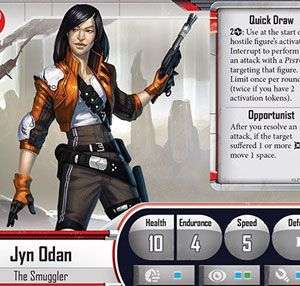 The Campaign will generally last around 15 missions, this includes side missions and Rebel character specific missions. Missions generally take around 45-60 minutes to complete depending on how efficient players are in terms of their moves and, to an extent, how good their dice rolls are. There are about thirty missions detailed in the Campaign Guide and the choice of mission that comes up will vary depending on the success or failure of the Rebels during previous missions, along with an element of randomness thanks to a mission deck. The Imperial player can also force the Rebels to play certain missions in order to prevent bad things from happening. For example, the Imperial player can put a mission into the side mission deck which faces the Rebels off against Darth Vader. If this comes up, the Rebels can choose not to play it, but if they don’t Vader will become available to the Imperial player for all subsequent missions!
The Campaign will generally last around 15 missions, this includes side missions and Rebel character specific missions. Missions generally take around 45-60 minutes to complete depending on how efficient players are in terms of their moves and, to an extent, how good their dice rolls are. There are about thirty missions detailed in the Campaign Guide and the choice of mission that comes up will vary depending on the success or failure of the Rebels during previous missions, along with an element of randomness thanks to a mission deck. The Imperial player can also force the Rebels to play certain missions in order to prevent bad things from happening. For example, the Imperial player can put a mission into the side mission deck which faces the Rebels off against Darth Vader. If this comes up, the Rebels can choose not to play it, but if they don’t Vader will become available to the Imperial player for all subsequent missions!
In terms of gameplay, Imperial Assault is very much like Descent 2nd Edition, a dungeon crawling miniature game also by Fantasy Flight. However, things have been improved somewhat since then. For example, a problem in Descent was that the Overlord player could quite easily just concentrate his attacks on just one player and keep him pinned down, which would weaken the rest of the team considerably. This is addressed in Imperial Assault by adding a Wounded mechanic to the game. The Rebel heroes have a set number of health points and, once this reaches zero, rather than being dead/incapacitated, that Rebel player will flip his character card over to the Wounded side. The Rebel will then have reduced stats and will be less powerful, however the Imperial player is then not allowed to attack that character any longer. If all the Rebel players become wounded then they automatically lose that mission. I think that this is a really good way to prevent ganging up and, while it doesn’t really make sense thematically, it does in terms of gameplay and balance. Speaking of balance, the Campaign is best played with four Rebel heroes against the Imperial player. If there are any less than this then the Rebel players need to add modifiers to their characters, which increase their health points, and give extra activations to the Rebels in order to compensate for the higher Imperial to Rebel ratio.
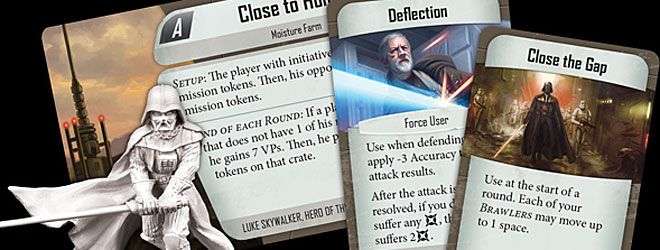
Overall the Campaign is bloody excellent, but the main problem I have found is simply getting the same people together on a regular basis in order to play. It’s because of this that I’m still playing my first campaign as I type this. This isn’t necessarily a point against the game, it’s just frustrating because the story and the gameplay is so good. However, I have heard a couple of negative things from friends who are also playing the campaign. For example, it’s possible that a run of bad missions for the Rebels can create a situation in which the Imperial player is now extremely powerful and the game becomes an uphill struggle for the Rebel players. Alternatively the same is true for the Imperial player as the Rebels become God-like in their abilities, making it very difficult for the Imperials to catch up. Also, due to certain decks of cards and whatnot needing to stay the same between missions and play sessions, you can’t really play more than one campaign at a time. This probably won’t be an issue for most people, but if you’re planning on playing this with different groups of people at the same time you’re going to have problems.
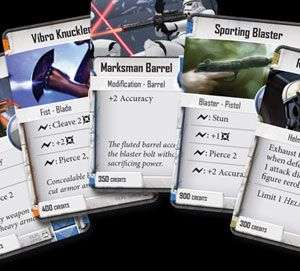 As for the Skirmish mode, this is a two player only, 1v1 scrap. Both players will create a squad of either Rebel, Imperial or Scum & Villainy units up to a value of 40 points. More powerful units obviously cost more points to field, while the less powerful units, such as Stormtroopers can be fielded in great numbers. The trick is to finding a good balance. Just fielding a few high-cost units isn’t always the best idea.
As for the Skirmish mode, this is a two player only, 1v1 scrap. Both players will create a squad of either Rebel, Imperial or Scum & Villainy units up to a value of 40 points. More powerful units obviously cost more points to field, while the less powerful units, such as Stormtroopers can be fielded in great numbers. The trick is to finding a good balance. Just fielding a few high-cost units isn’t always the best idea.
Once you’ve picked your squad, players need to decide which scenario to do battle over. The core game comes with three map set ups, each with two scenarios. This is enough to be getting started with but if you intend on playing this mode regularly you may want to invest in some of the Ally and Villain expansion packs which, as well as new units and cards, all come with new scenarios to play.
In order to win a skirmish match, a player must reach 40 Victory Points before his opponent. Each scenario will have its own objectives which give bonus points for doing certain things such as capturing items or killing raiders and the like, however these only give a small number of points and most of these will come from fighting your opponent. The gameplay is pretty much the same as the Campaign, but there are some tweeks in order to preserve balance. For example, in the campaign mode, the Rebels can choose to attack twice for their two attacks, whereas in Skirmish the units can only attack once unless they have a skill/power which allows them to do otherwise.
The other main difference between Campaign mode and Skirmish is the addition of Command Cards. These are single-use cards which either aid you or hinder your opponent. Each player must have fifteen of these cards. Every card will have a value from 0-3; the cards worth 3 are quite powerful, while the cards which are worth 0 points aren’t always that useful. At the start of the game three command cards are drawn from your deck, with one card drawn at the start of each subsequent round. Additional cards can be drawn for every terminal that a player controls on the map. The challenge is building a deck that compliments your squad well as you can’t have too many three or even two point cards as it means you have to dilute them with 0 point cards in order to stay at fifteen points. Games can be won and lost on the quality of your command deck so it can be quite important.
I really enjoyed the Skirmish mode and I’ve found that most of my time with this game has been spent skirmishing. This may have something to do with it only requiring two players but it’s also due to the large number of unit compositions available straight out of the box. The main downside I see to this mode is “The Meta.” By this I mean the current trend of players working out the most effective combinations of units to play with. This is especially prevalent in the competitive scene but I’ve seen it leak into friendly matches as well, which I think is a bit sad and takes away from the fun of just knocking a team together and having fun.
To wrap things up, once you’re over the initial cost of purchasing Imperial Assault, RRP £79.99, you’ll find that there is quite a lot of game to go with the extravagant price tag. The game is a joy to play and I personally think that the price of entry is worth it, especially if you can get four other people together to play the Campaign. If you can’t get that many people together too often, the Skirmish mode has plenty of legs in it to keep you going between Campaign sessions. Additionally, everything is of exceptional quality, from the miniatures to the dice, right down to the cardboard tokens and map tiles. There are a few niggles to contend with but nothing that is game-breaking in nature. Star Wars Imperial Assault really is a game worthy of carrying the Star Wars name.
Pros- 2 games in a box (Campaign & Skirmish)
- Excellent component quality
- Easy to learn gameplay makes it accessible to most players
- Great RPG element to the Campaign
- Star Wars!
- Expensive! (Because its Star Wars)
- Only one Campaign can be played at a time
- The “Meta” can suck the fun out of Skirmish
I really love Imperial Assault, it may not be as exciting as dogfighting in X-Wing, or have the grand scale of fleet battles in Armada but it certainly is fun to play. The campaign is wonderful, and the Skirmish mode is fantastic as well - you are effectively getting two games for your money here.
The easy-to-learn nature of the game means that you’ll be up and running in no time at all, and there’s depth in the customisation options to keep you coming back and experimenting with what you can do.
Component quality is excellent also, true effort has gone into the making of the miniatures and if you can manage to paint them well enough they look amazing. The downside for most will be the price, and the expandable nature of the game will also be tough going on your wallet if you are a completionist. If you can afford it then I think the price tag justifies the fun you will get out of it. Despite a few niggles, I can’t recommend this game enough if you’re a fan of Star Wars or miniatures games in general. Stop reading this and go buy it, or at least come round to mine so I can finish off this bloody campaign!
Last five articles by Ste
- Acoustic Gaming: X-Wing Miniatures Game - Review
- Acoustic Gaming: Pandemic Legacy – Season One
- Bored Gaming
- U Wot Mate?
- Tabletop Simulator - Review














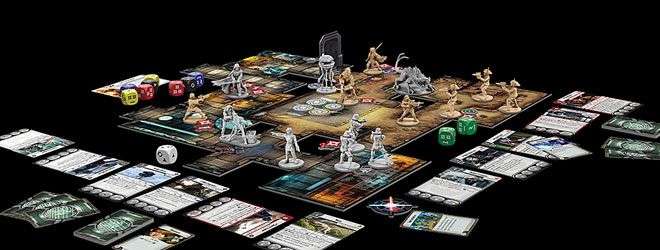






Just a note, since this was written the second expansion pack has been released and a 3rd was recently announced. Each expansion adds new Rebel and Imperial characters, as well as new weapons, upgrades and also a whole new campaign including new map tiles to play on.